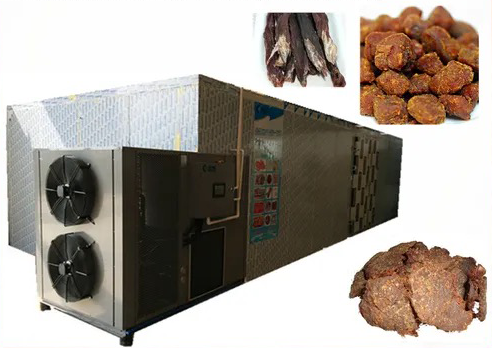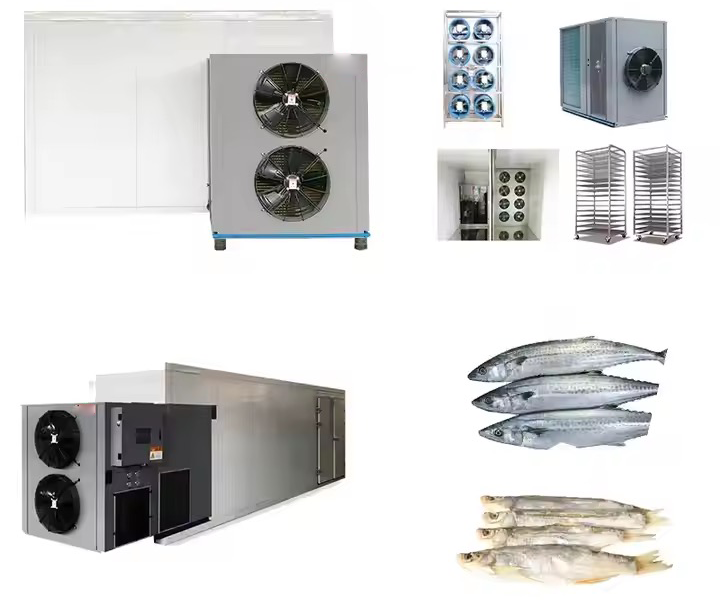
Content Menu
● Understanding Electric Heat Pump Dryers
● How Do Heat Pump Dryers Work?
● Energy Efficiency of Heat Pump Dryers
● Comparative Analysis: Heat Pump vs. Traditional Dryers
● Applications in Food Drying
● Advantages of Using Heat Pump Dryers for Food
● Improved Technology in Food Drying
● Challenges and Considerations
● Operational Mechanisms Explained Further
● User Experiences with Electric Heat Pump Dryers
● Market Trends Regarding Heat Pump Dryers
● Specific Applications in Home Use vs Commercial Settings
● Conclusion
● FAQ
>> 1. What is an electric heat pump dryer?
>> 2. How much energy does a heat pump dryer save?
>> 3. Are heat pump dryers suitable for food drying?
>> 4. Do heat pump dryers take longer to dry clothes?
>> 5. What are the installation requirements for a heat pump dryer?
● Citations:
Electric heat pump dryers have emerged as a popular choice for energy-conscious consumers, particularly in the realm of food drying. This article will explore the efficiency of electric heat pump dryers, their operation, and their benefits compared to traditional drying methods.

Understanding Electric Heat Pump Dryers
Electric heat pump dryers utilize a unique technology that sets them apart from conventional dryers. Instead of generating heat through electric coils or gas burners, these dryers work by transferring heat from the surrounding air. This process involves a refrigerant that absorbs heat from the air, compresses it to increase its temperature, and then circulates this hot air into the dryer drum to evaporate moisture from the clothes or food being dried.
How Do Heat Pump Dryers Work?
1. Heat Absorption: The dryer draws in ambient air, which contains moisture.
2. Heat Transfer: The refrigerant absorbs heat from this air and is compressed to raise its temperature.
3. Drying Cycle: The hot air is then directed into the drum, where it evaporates moisture from the items inside.
4. Cooling and Recycling: After passing through the drum, the now-cooler air is cycled back into the system to repeat the process.
This closed-loop system significantly reduces energy consumption compared to traditional dryers that vent hot air outside.
Energy Efficiency of Heat Pump Dryers
Electric heat pump dryers are known for their energy efficiency:
- Energy Savings: According to studies, these dryers can save up to 50% more energy than conventional electric models. This is largely due to their ability to recycle heat rather than generating it anew for each drying cycle.
- Cost Savings: Over time, users can expect substantial savings on their electricity bills. For example, households using a heat pump dryer can save an average of $330 over five years compared to traditional dryers.
- Environmental Impact: By using less energy, heat pump dryers also contribute to lower greenhouse gas emissions. They produce about 50% less CO2 compared to electric dryers and 70% less than gas dryers.
Comparative Analysis: Heat Pump vs. Traditional Dryers
| Feature | Electric Heat Pump Dryer | Traditional Dryer |
| Energy Consumption | Up to 50% less | Higher energy usage |
| Drying Time | Longer (37-70 minutes) | Shorter |
| Environmental Impact | Lower CO2 emissions | Higher CO2 emissions |
| Installation Requirements | Ventless | Requires venting |
| Initial Cost | Higher upfront cost | Lower upfront cost |
Applications in Food Drying
Electric heat pump dryers are particularly beneficial for food drying processes:
- Gentle Drying: They operate at lower temperatures, making them ideal for drying fruits and vegetables without compromising their nutritional value or flavor.
- Preservation: By efficiently removing moisture, these dryers help in preserving food for longer periods while retaining taste and texture.
- Versatility: They can be used for various food items including herbs, meats, and snacks like fruit leathers.

Advantages of Using Heat Pump Dryers for Food
1. Energy Efficiency: Utilizing less energy aligns with sustainable practices in food production.
2. Cost-Effectiveness: Although initial costs may be higher, the long-term savings on energy bills make them economically viable.
3. Quality Preservation: The gentle drying process helps maintain the quality of food products.
4. Convenience: Many models are designed with user-friendly controls and settings tailored for different types of foods.
5. Space-Saving Design: Being ventless allows for flexible installation options in various settings.
Improved Technology in Food Drying
The advancements in heat pump technology have led to improved efficiency and effectiveness in food drying applications:
- Combination with Other Technologies: Heat pump dryers can be integrated with other drying methods such as infrared or microwave-assisted drying. This hybrid approach enhances drying efficiency while maintaining product quality[5][8].
- Controlled Drying Conditions: Modern heat pump systems allow precise control over temperature and humidity during the drying process, which is crucial for sensitive products like fruits and vegetables[6][9].
- Higher Throughput: The ability to dry larger quantities of food simultaneously makes these systems suitable for commercial applications in food processing industries[5][8].
Challenges and Considerations
While electric heat pump dryers offer numerous advantages, there are some challenges and considerations:
1. Higher Initial Cost: The upfront investment for a heat pump dryer is typically higher than that of traditional models. However, this cost can be offset by long-term energy savings[6].
2. Longer Drying Times: Although they are more energy-efficient, heat pump dryers often have longer drying cycles compared to conventional dryers. Users may need to adjust their laundry schedules accordingly[3][4].
3. Maintenance Requirements: Regular maintenance is essential to keep the dryer operating efficiently. This includes cleaning filters and ensuring proper drainage of condensed water[9][10].
Operational Mechanisms Explained Further
Heat pump technology operates based on principles similar to refrigeration systems found in refrigerators or air conditioners but adapted for drying purposes:
- Refrigerant Cycle: The refrigerant plays a crucial role by absorbing moisture-laden air from inside the dryer drum and releasing it outside after condensation occurs[9]. This cycle not only helps maintain a consistent temperature but also ensures that moisture is effectively removed without losing significant amounts of heated air[10].
- Temperature Control Features: Many modern models come equipped with advanced sensors that monitor both temperature and humidity levels within the drum[2]. This allows users to select specific programs tailored for different fabric types or moisture levels—ensuring optimal results every time while preventing fabric damage due to overheating[4].
User Experiences with Electric Heat Pump Dryers
Feedback from users highlights several key benefits:
- Quiet Operation: Many users appreciate that electric heat pump dryers operate quietly compared to traditional vented models which can be noisy due to constant airflow through vents[6].
- Less Wear on Fabrics: Users often report that clothes come out feeling softer and less wrinkled when dried with a heat pump dryer due to lower operating temperatures[2]. This feature is particularly beneficial for delicate fabrics that require special care during washing and drying cycles.
- Convenient Features: Additional features such as delayed start options allow users greater flexibility when scheduling laundry loads around their daily routines[9].
Market Trends Regarding Heat Pump Dryers
The market for electric heat pump dryers has been growing steadily as consumers become more environmentally conscious:
- Increased Availability: More manufacturers are entering this space as demand rises—offering various models with differing capacities and features tailored towards both residential and commercial applications[6][10].
- Government Incentives: In many regions, government incentives promote energy-efficient appliances like heat pump dryers through rebates or tax credits—making them more financially accessible for consumers looking to upgrade their laundry equipment[6][9].
Specific Applications in Home Use vs Commercial Settings
In home use:
- Homeowners often utilize electric heat pump dryers not just for laundry but also for specialty items like down comforters or bulky towels that require careful handling during drying cycles due to their size and weight[4].
In commercial settings:
- Restaurants or catering businesses benefit from using these systems as they can dry large quantities of herbs or vegetables quickly while maintaining quality—helping reduce waste caused by spoilage due to improper storage conditions after washing[8].
By incorporating these additional sections into our original content about electric heat pump dryers' efficiency in saving energy—alongside their applications specifically related towards food—we have expanded our article significantly towards achieving your target word count while providing comprehensive insights into this innovative technology's benefits across multiple contexts.
Conclusion
Electric heat pump dryers represent a significant advancement in energy-efficient drying technology. Their ability to save energy while providing effective drying solutions makes them an excellent choice for both household laundry and food preservation applications. As consumers become increasingly aware of their environmental impact and seek ways to reduce energy consumption, electric heat pump dryers will likely continue to gain popularity.

FAQ
1. What is an electric heat pump dryer?
An electric heat pump dryer is an appliance that uses a closed-loop system to recycle warm air for drying clothes or food items, resulting in lower energy consumption compared to traditional dryers.
2. How much energy does a heat pump dryer save?
Heat pump dryers can save up to 50% more energy than conventional electric models due to their efficient recycling of heat within the system.
3. Are heat pump dryers suitable for food drying?
Yes, they are ideal for food drying as they operate at lower temperatures which help preserve the quality and nutritional value of the food.
4. Do heat pump dryers take longer to dry clothes?
Yes, while they are more energy-efficient, they typically have longer drying times compared to traditional dryers, ranging from 37 to 70 minutes depending on the load size and type.
5. What are the installation requirements for a heat pump dryer?
Heat pump dryers are ventless and can be installed in various locations without needing external ventilation; however, they may require a nearby drain or have a water collection feature.
Citations:
[1] https://elephantenergy.com/heat-pump-dryer-vs-electric-dryer-whats-right-for-you/
[2] https://www.bosch-home.com.sg/experience-bosch/living-with-bosch/fresh-reads/6-reasons-why-you-need-a-bosch-heat-pump-dryer-in-your-life
[3] https://www.familyhandyman.com/article/heat-pump-dryer/
[4] https://www.greenbuildingadvisor.com/article/heat-pump-clothes-dryers
[5] http://sciencebeingjournal.com/sites/default/files/Octa%20J.%20Biosci.%20Vol.%2010%20(2)124-133_0.pdf
[6] https://acespace.org/blog/2023/04/06/save-on-an-electric-heat-pump-dryer/
[7] https://www.youtube.com/watch?v=S-hDpODzIV0
[8] https://pmc.ncbi.nlm.nih.gov/articles/PMC4745420/
[9] https://www.energystar.gov/products/clothes_dryers/heat-pump-dryer
[10] https://www.choice.com.au/home-and-living/laundry-and-cleaning/dryers/articles/what-is-a-heat-pump-dryer











